I am currently sitting in a rink in Weyburn, Saskatchewan, “watching” Derek at hockey camp. Thanks to my techie husband, I came equipped with a netbook (a small laptop computer) and some kind of stick that plugs in and gives me internet access. Thus I am able to vie for the coveted “Mother of the Year Award” by being at the rink, as well as catch up on my blogging for my two faithful readers! Ah, the wonders of technology.
I thought I would continue my Ussongo saga by delving into the Tanzanian education system. I’m sure I don’t fully understand it, after a whole 10 days there, but I will try to give you a picture of what we saw.
Tanzania has primary and secondary schools, as we have here. They do not refer to “grades”, but “forms”. The children start at age 4 or 5 by attending a type of kindergarten at a publically funded school. They attend the primary school until about the age of 12. If the parents can afford it, the student might attend a secondary school beginning in Form 1. The rural parents also must be able to afford having a worker away at school. Even the primary schools suffer poor attendance in the rural areas as the children are needed to help with hauling water, hoeing fields, herding livestock, and harvesting. 
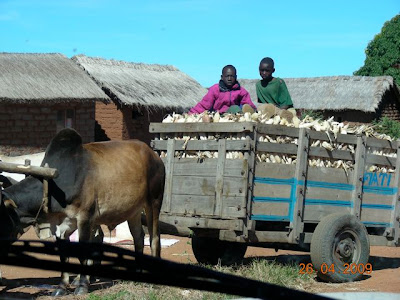
Many of the secondary schools are boarding schools, and may be public or private. Many of the private schools are run by religious organizations, such as St. Thomas Aquinas School at Ussongo. St. Thomas was started by Father Chuwa 10 years ago, and has grown in size and stature to become the third best secondary school in Tanzania.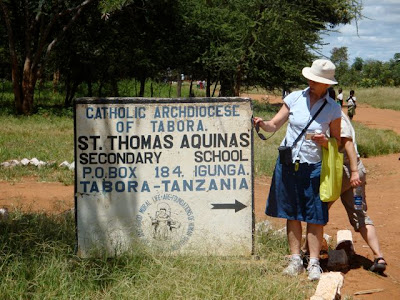
The courtyard at the school grounds.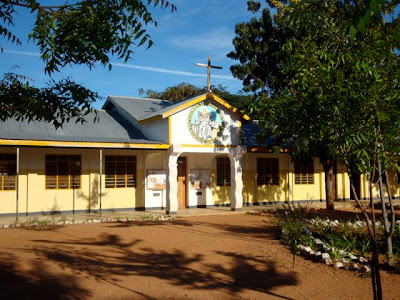
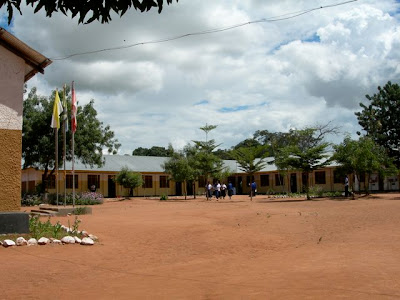
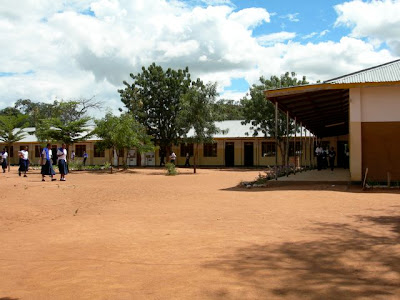 The students come from all parts of the country. They are very motivated to learn, as the $800 US yearly tuition is prohibitive, and many times only one child per family is able to attend. Classes are held six days per week, at least, with Saturday being a “day off”, meaning the students have time to shower, wash clothes, and clean the extremely crowded dorms. A typical weekday at St. Thomas begins with Mass at 6:45 AM, after which the students go to assembly in the school courtyard.
The students come from all parts of the country. They are very motivated to learn, as the $800 US yearly tuition is prohibitive, and many times only one child per family is able to attend. Classes are held six days per week, at least, with Saturday being a “day off”, meaning the students have time to shower, wash clothes, and clean the extremely crowded dorms. A typical weekday at St. Thomas begins with Mass at 6:45 AM, after which the students go to assembly in the school courtyard. 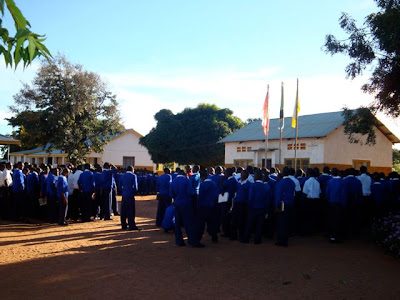 The first day we were there, two students were kneeling in front of the assembled students and obviously being chastised and humiliated for some wrong-doing. We never did discover what had happened. Classes begin after assembly. Breakfast is at 10:30, and consists of a runny corn (maize) porridge called ugi. The morning we toured the school it was ready and waiting in huge vats at 8 AM. Yum! Some of the students are fortunate enough to have spending money to purchase sugar at the canteen to sweeten the ugi, while others forego it altogether and wait it out until lunch at 2:30. This is the dining hall.
The first day we were there, two students were kneeling in front of the assembled students and obviously being chastised and humiliated for some wrong-doing. We never did discover what had happened. Classes begin after assembly. Breakfast is at 10:30, and consists of a runny corn (maize) porridge called ugi. The morning we toured the school it was ready and waiting in huge vats at 8 AM. Yum! Some of the students are fortunate enough to have spending money to purchase sugar at the canteen to sweeten the ugi, while others forego it altogether and wait it out until lunch at 2:30. This is the dining hall.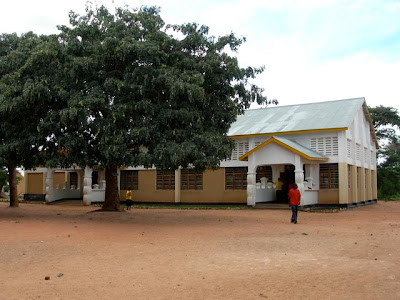 This is the canteen where the students shop on Saturdays for their “extras” – soap, laundry soap, sugar, oil, etc.
This is the canteen where the students shop on Saturdays for their “extras” – soap, laundry soap, sugar, oil, etc.  Lunch is another culinary treat consisting of a stiffer corn porridge (ugali) which the students pick up with their hands to dip in a sort of bean stew. Again, the more fortunate students are able to purchase sunflower oil to make the meal more palatable.
Lunch is another culinary treat consisting of a stiffer corn porridge (ugali) which the students pick up with their hands to dip in a sort of bean stew. Again, the more fortunate students are able to purchase sunflower oil to make the meal more palatable.  After lunch, the students have chores, such as cleaning, weeding the grounds, and working in the fields. The road into the school is flanked by rows of trees, which were planted and are maintained by the students. Keep in mind that the ground was all broken by hand, and the weeding is done the same way!!
After lunch, the students have chores, such as cleaning, weeding the grounds, and working in the fields. The road into the school is flanked by rows of trees, which were planted and are maintained by the students. Keep in mind that the ground was all broken by hand, and the weeding is done the same way!!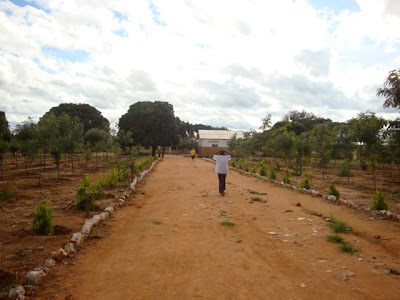
A pile of hoes and containers for water that the students use when weeding.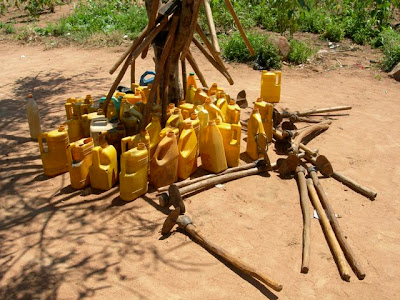 It was harvest time when we were there, and the students were busy harvesting maize. The ears are gathered from the field and laid out in an old classroom to dry. Once dry, the ears are beaten with sticks to remove the grains of corn. The empty cobs are gathered up and the corn is put in sacks and taken to be milled into flour.
It was harvest time when we were there, and the students were busy harvesting maize. The ears are gathered from the field and laid out in an old classroom to dry. Once dry, the ears are beaten with sticks to remove the grains of corn. The empty cobs are gathered up and the corn is put in sacks and taken to be milled into flour. 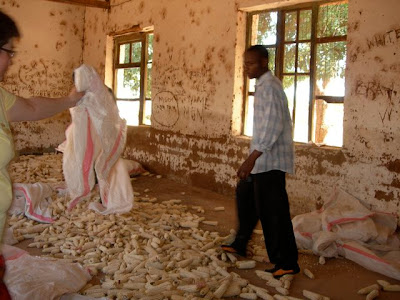
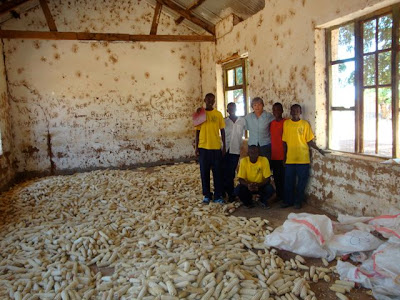 Evening prayer is at 5 Pm, followed by supper – the exact same meal as lunch – and then three hours of studying in the classrooms, often unsupervised, as the students help each other with homework.
Evening prayer is at 5 Pm, followed by supper – the exact same meal as lunch – and then three hours of studying in the classrooms, often unsupervised, as the students help each other with homework. 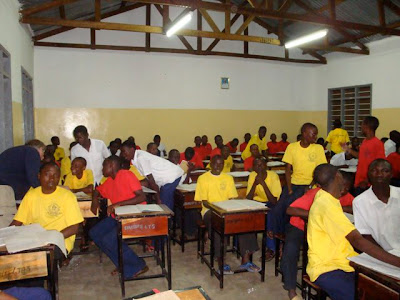
On Saturday, a beef is butchered, and the school receives 70 kilograms (for 600+ students!), so the evening meal on Saturday is rice and beef stew.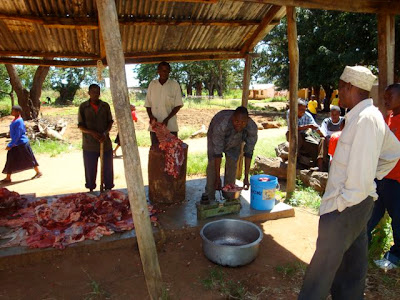
A couple of classrooms that we interrupted! There are about 60 students in each class. They are required to wear uniforms to school, but may wear the more casual T-shirts for study hall.
 Some students between classes.
Some students between classes.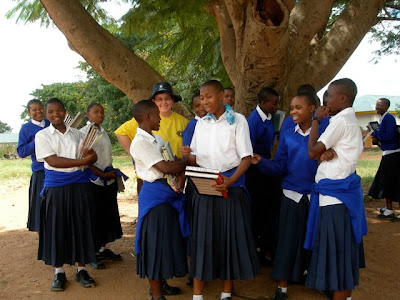
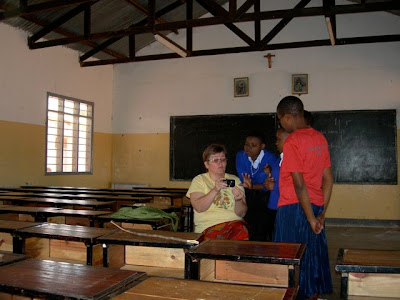
We were able to tour the girls dorms. There are three large dorms in a fenced and gated area way across the school grounds from the boys’ dorms. The bunk beds are literally stuffed into the dorms, and there is barely enough room to walk between the rows of beds. Their belongings must be kept either on or under the beds, but some enterprising students rigged up a system to hang bundles from the ceiling. Some of the students also have mosquito nets hanging above their beds. The girls bathe themselves outside by the far wall. They also wash their clothes there. 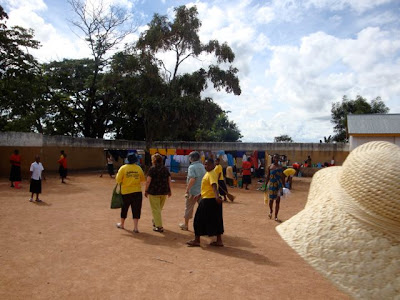 There is a TV, but it didn’t sound like they got to watch it very often. And I’m not sure what they are able to watch, anyway. Perhaps movies. Malaria is rampant in the school, probably due in part to the close quarters.
There is a TV, but it didn’t sound like they got to watch it very often. And I’m not sure what they are able to watch, anyway. Perhaps movies. Malaria is rampant in the school, probably due in part to the close quarters. 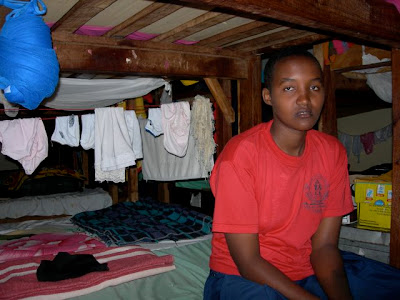

The girls were playing a counting game in the dirt. I never did find out the name of the game, nor did we ever understand how it is played!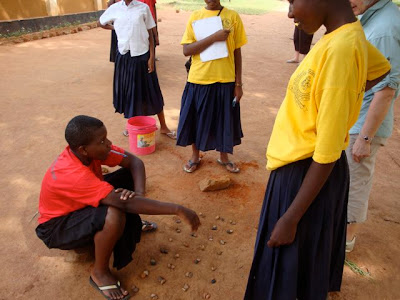
We saw a few other buildings and such when we toured the school. This the new library which has been built with the help of one of our group, Norm. He is also raising money to have a container of donated books sent to Ussongo. In the picture you see pretty much all the books the library currently contains! Mussa Protas is the librarian, and we are staying in touch via very infrequent emails!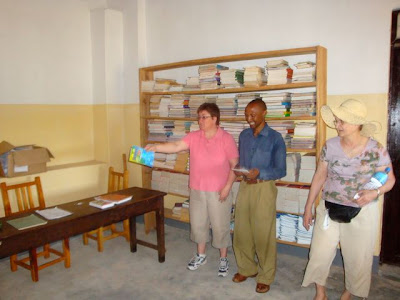
There is other new construction, as well. We came across some workers building new housing for the teachers. They were as eager as the children to have their pictures taken. I was again amazed at how much construction was done manually.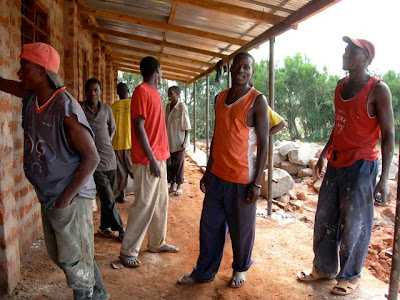

These teacher accommodations were finished a couple of years ago. 
The academics headmaster invited us to his home to meet his wife and daughter. The room was quite modern, and he had a very antiquated computer in a place of honor in the living room. 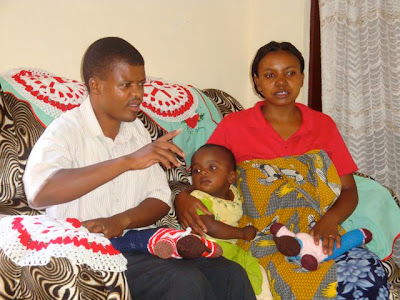
We also got to visit two primary schools. The first was in Ussongo, and seemed to be better off than the second one we visited a couple of miles away. They are both publicly funded schools. The first school also took care of about 30 orphans. The children stayed with local families, but the school provided their meals and clothing, etc. Esther is the principal at the school, and is a wonderful person. All of the 400 or so students assembled outside for our visit, and some of them had prepared songs and dancing, accompanied of course with drums. It was incredible.
One of the orphans was an albino. We all wanted to give her our hats and sunglasses and sunscreen. Her arms were scarred from sunburns, and she was constantly squinting in the sun. 
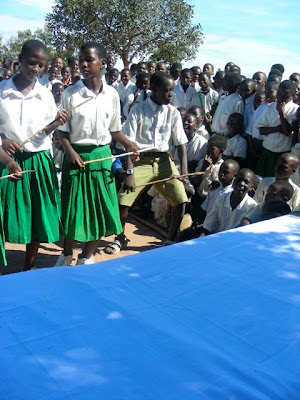

We were able to go individually to some of the classrooms and talk to the students. They do not learn English at this school, so the teachers translated. I had taken along a little booklet of photographs of our farm, the machinery, the crops, and snow and hockey. They absolutely loved it, and I became known as the “lady with the book”. It helped to show them how we live in Canada. They just cannot fathom how we do not all freeze to death in the winter. One picture of Derek playing in the snow was particularly intriguing to them. Some of the others in our group took a younger class and taught them a little rhyme with actions. They liked that as well.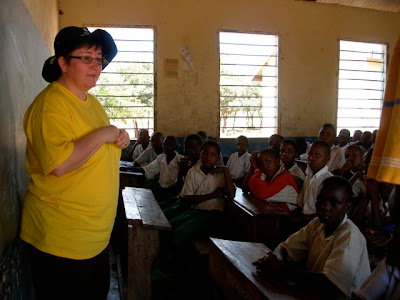
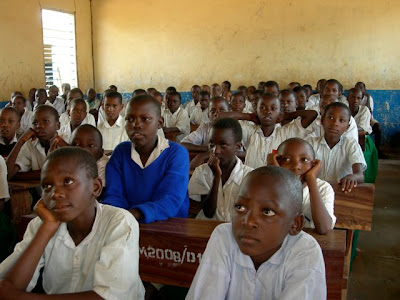

You may have noticed the hairstyles – all the children, boys and girls, keep their heads shaved close. I am sure it is for sanitary reasons.
All of our group had our suitcases packed with things to give to the school and the health clinic. One of the things they appreciated most was some sort of sports equipment. Anita presented the primary school with a soccer ball.
Esther, the principal of the primary school, came to church dressed in traditional African clothing and brought her children for us to meet. Some of the other village children got in the picture, as well!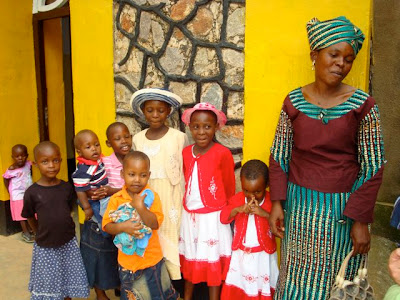
All of the children wanted to have their pictures taken, and these typical boys posed for an action shot!

Some village children decided we needed escorts on our way to the school. They insisted on carrying our water bottles and holding our hands and, of course, having their pictures taken!They were too cute!
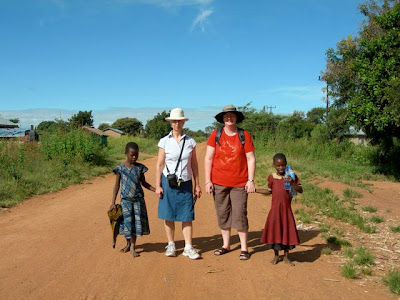
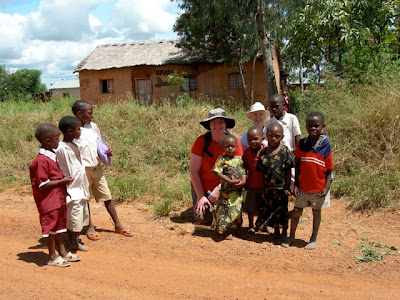
One of the long roads in the village.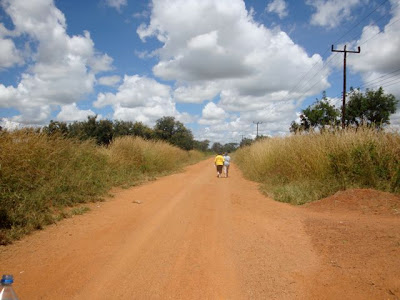
We hadn’t planned to visit another primary school, but one of our drivers, Adriano, had a friend, Very, who taught at a school in a neighboring village. This school was in a much poorer village, and it showed. The uniforms, though clean, were ill-fitting and tattered, and many of the children were barefoot. There were also many more Muslim children at this school. None of the children spoke English, and the teachers, except Very, spoke very little. Very said that many of the students were malnourished, and probably only recieved one meal a day at home, and an inadequate one at that. But again, they all seemed to be very happy, and eager to have their picture taken.
We were once again treated to songs, in particular the Tanzanian national anthem. 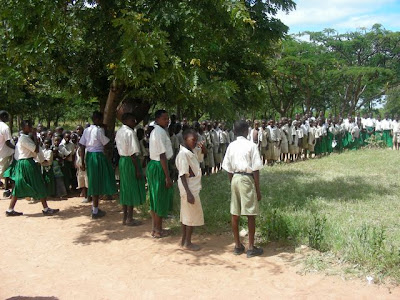
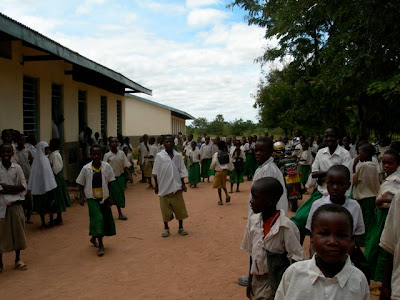
These are the teachers. Very is in the red plaid shirt, and to the left of him, in the blue shirt, is Adriano.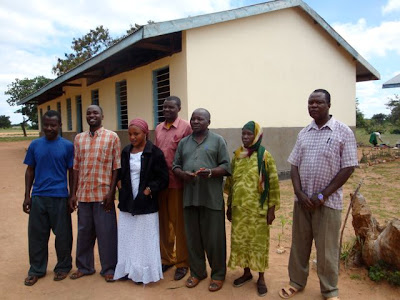
We brought them a map of Canada, with which they were quite pleased!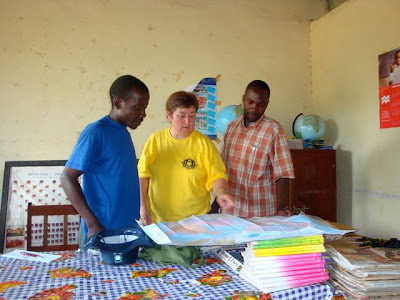
The children that can bring lunches with them to school. It seemed that part of the children’s duty was to prepare lunch for the teachers. 
All in all, it was a very enlightening experience, and I am so glad we got to meet Very and see the second primary school. It was a much more intimate encounter with Tanzanian life!
Well, due to the huge learning curve on this netbook, trying to watch hockey, and my own ineptitude, it has taken me three days to create this post!! Hopefully the next one will be less painful! Derek and I leave for home tomorrow. We might just drive right to North Battleford, where Stephen is at the AAA Midget camp. Can’t get enough of a rink in August!!!
Thanks for checking in!
Chandra


Hi Chandra,
Very interesting article and photos were great as it reminds me of how rural Botswana was back in the 1990's.
Cheers from the 'Rock',
carl
I ditto Wilma's comments–fabulous!!
Thanx for more pics & stories of your trip. What an amazing experience!